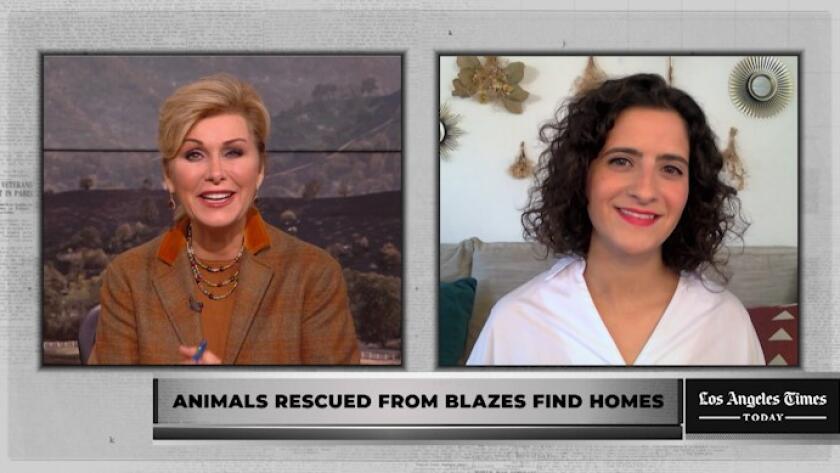Cougar cubs, raccoons, kitty cats. After rehab, animals hurt by fires find new homes
- Share via
California’s record wildfire season may not be completely over, but the trauma is ending for some of the state’s most vulnerable inhabitants: animals rescued from the blazes.
Several animals found injured during wildfires this year have recovered and will soon be welcomed into new homes.
One happy caregiver welcomed home her “semi-feral” cat, Ned, after he spent three months recovering from burns to his feet, face, ears, hind leg and tail at the hospital at the UC Davis School of Veterinary Medicine.
The cat was rescued at Linda Kearney’s property in Vacaville, where he escaped from the LNU Lightning Complex fire, according to a UC Davis news release. Kearney managed to save 12 other cats that had been on her property, but one died and another remains missing. She plans to build sheds to house the animals on her property, according to the release.
“Being semi-feral, Ned was not always a cooperative patient,” said Kate Hopper, director of UC Davis’ Small Animal Clinic, in a statement. “His care team did a stellar job powering through that daily adversity to make sure he fully recovered.”
UC Davis treated more than 1,000 animals, both wild and domestic, affected by the LNU Lightning Complex fire, according to its website. Spokesman Rob Warren said the hospital responded to another 1,200-plus victims of the North Complex fire.
Many of the animals evaluated were deemed to be healthy and were moved to evacuation centers or sheltered in place, Warren said. The worst cases were brought to the university hospital for treatment — a total of 97 from both fires, similar to numbers in previous years, Warren said.
California Department of Fish and Wildlife treated fewer than 10 animals for burns this wildfire season, said spokeswoman Kirsten Macintyre.
On the wilder side, a raccoon dubbed Burnie was rescued from the Blue Ridge fire near Anaheim. The raccoon, estimated to be between 2 and 3 years old, arrived at the Wetlands & Wildlife Care Center in Huntington Beach on Nov. 2 covered in smoke and soot, said executive director Debbie McGuire.
A property owner had hired a trapper to catch another animal, but the raccoon had gotten stuck in it. McGuire couldn’t confirm how long the raccoon had been stuck there, or how close the fire had come to it.
“He was very lucky that he didn’t get burned or [die] because of being trapped, but he was pretty smoky,” McGuire said.
Once the evacuation order for the area was lifted, the trapper went back, discovered the raccoon and turned him over to OC Animal Care, which handed him off to the Wetlands & Wildlife Care Center, according to McGuire.
Burnie suffered first- and second-degree burns on his front legs and paw pads, plus minor abrasions to his nose. When staff conducted X-rays, they found he had also been shot, McGuire said.
“I was like, ‘Great, and on top of everything else, somebody tried to shoot you!’” McGuire said.
After treating his wounds for two and a half weeks, the center’s staff released Burnie back into the wild near where he was found.
A trio of mountain lion cubs have also licked their wounds from the devastating Zogg fire and are headed for a new home in Columbus, Ohio. Firefighters found “Capt. Cal” wandering alone a month and a half ago in Shasta County with singed whiskers and burned paws. He was brought to the Oakland Zoo, where he underwent surgery, hand-feeding and 47 days of round-the-clock care. Soon, twin female mountain lion cubs, estimated to be 5 weeks old when they lost their mother in the Zogg fire, joined him.
The three cubs will take their first flight with zoo officials to Indianapolis, then will travel to the Columbus Zoo and Aquarium. Zoo officials in Ohio hope to eventually introduce the cubs to Jessie, a nearly 17-year-old blind mountain lion who lost her brother Billy earlier this year, according to an Oakland Zoo news release.
“Even with the cubs’ tragic beginning, their story is actually one of survival and hope,” said Tom Stalf, president and chief executive of Columbus Zoo and Aquarium, in a statement. “We remain committed to the cubs’ care, and we will continue to share their important story with others as we work together to protect the future of wildlife and wild places.”
- Share via
Watch L.A. Times Today at 7 p.m. on Spectrum News 1 on Channel 1 or live stream on the Spectrum News App. Palos Verdes Peninsula and Orange County viewers can watch on Cox Systems on channel 99.
More to Read
Sign up for Essential California
The most important California stories and recommendations in your inbox every morning.
You may occasionally receive promotional content from the Los Angeles Times.












